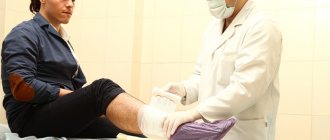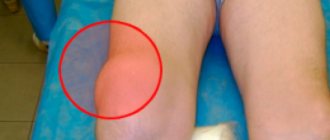Flat feet is a change in the shape of the foot, in which its transverse and longitudinal arches become flattened. This foot disease occurs 10 times more often in women than in men. This is facilitated by a number of factors, one of which is, for example, wearing high-heeled shoes.
1
Flat feet. Treatment of foot deformities and diseases
2 Flat feet. Treatment of foot deformities and diseases
3 Flat feet. Treatment of foot deformities and diseases
Symptoms
Most often, the patient does not experience any sensations, only a certain disturbance in gait, which can be noted by others or the doctor. The main symptom is ankle pain, which may increase with exercise. There may also be swelling in the ankle area. Symptoms can vary and usually depend on the severity of flat feet. Some people have uneven distribution of body weight and the person may notice that the heel of the shoe wears out faster on one side than the other. The most common symptoms of flat feet are:
- Pain in the ankle area (inside), there may also be swelling there
- Pain in the foot area
- Pain in the arch of the foot
- Calf pain
- Knee pain
- Pain in the hip area.
- Back pain
- Patients with flat feet may also experience stiffness in one or both legs.
- One or both feet can be placed flat on the ground.
- Uneven shoe wear.
Prevention of flat feet in children
Read more…
Prevention of flat feet in children begins from the first year of life. At this age, it will consist of the prevention and treatment of rickets and other neurological diseases that can cause flat feet. We should not forget that no shoe, even the most useful one, can replace a child’s barefoot walk on grass, sand and other natural uneven surfaces. Research by Indian doctors shows that those who spent a “barefoot” childhood are three times less likely to suffer from flat feet than those who wore shoes since childhood. However, there is one “But” in this rule. It is good for a child to walk barefoot on the grass, but walking barefoot on a completely flat and hard floor is harmful.
For older children, you can conduct special games with elements of foot gymnastics. Such gymnastics may include such simple exercises as walking on your heels, on your toes, on the outer and inner sides of the foot. Jumping in place, lifting your heels (while keeping your toes in place), crawling with your toes back and forth. It will be useful to roll gymnastic sticks with a diameter of 2-3 cm or tennis balls with your feet, lift small objects from the floor with your toes and climb gymnastic stairs. All this develops the muscles of the feet well and improves their blood supply.
Any gymnastics will show better results if it is combined with water procedures. For example, swimming is a good means of stimulating not only the tone of the body's skeletal muscles, but also hardening.
Causes
- Genetic determination.
- A weak arch may not be a problem while a person is sitting, but once they stand on their feet, they may fall.
- Injury
- Arthritis of the ankle joint of the foot
- Posterior tibial tendon rupture
- Pregnancy
- Diseases of the nervous system or muscles - such as cerebral palsy, muscular dystrophy, or spina bifida.
- Fusion of the tarsal bones can cause compaction and flat feet. Most often diagnosed in childhood.
- Diabetes
- Age-related changes. Long-term exercise (running, jumping, walking) can have negative consequences. One possible consequence may be flat feet. The tibialis posterior tendon can weaken after repeated microtears. The tibialis posterior tendon is the primary supporting structure of the arch of the foot. The tendon can become inflamed (tendinitis) after exercise or even rupture. Once the tendon is damaged, the arch of the foot may flatten.
The presence of flat feet in childhood is not a pathology, since the formation of the foot ends along with the end of the formation of the musculoskeletal system. In other words, the presence of flat feet in childhood does not mean at all that flat feet will persist in an adult. People with a low arch or no arch at all may not experience any problems until a certain time.
Where does flat feet come from?
The concept of “flat feet”
This word refers to the condition of the foot in which it is unnaturally smoothed and does not have arches, that is, concavities.
There are two of them:
- transverse;
- longitudinal.
When the foot becomes ill, it loses its shock-absorbing properties and thereby increases the load on the spine and legs.
Symptoms of the disease
You need to pay attention to the following signs:
, accompanied by swelling of the legs, pain, and a burning sensation in the calves, which makes itself felt closer to night.
Fatigue after a long walk- The appearance of clubfoot affects the load on the spine, which becomes arched and makes the gait unnatural.
- Pain sensations appear not only in the legs, but also in the back, neck, and hips. They arise due to improper load of body weight.
- Loss of balance. If a person with flat feet is asked to squat, he will find it very difficult to do so due to loss of balance.
- An ingrown toenail is one of the characteristic signs.
- Paint test. You can do a simple test - paint your foot with paint and stand on a piece of paper. If the contact zone is narrow in the center, then the foot is healthy. Otherwise, the diagnosis is flat feet, which is characterized by a wide imprint of the entire foot on paper.
- Shoes that wear out quickly , and women have heels on the inside.
- Walking in heels causes discomfort and pain.
- The bones are growing. With flat feet, bunions begin to appear on the feet over time due to foot deformation.
These symptoms can be found not only in adults, but also in children.
As soon as they appear, you should immediately consult an orthopedist for diagnosis and treatment of the disease. If flat feet are detected in the early stages, they can be successfully treated.
Causes of flat feet
There are several factors that are prerequisites for the disease:
- when there is a heavy load of weight, the foot cannot withstand and bends;
obesity- wrong shoes - narrow, big, uncomfortable. This leads to incorrect formation of the foot. You should know that children from a very young age should wear shoes with arch support;
- increased loads on the spine and legs are a problem for any athlete and people in difficult professions;
- injuries ;
- rickets is the most common cause. Appears due to vitamin D deficiency, as a result of which the bones soften and become pliable;
- sedentary work - if you stay in this position for a long time, the leg muscles weaken and are no longer able to hold the body in the correct position;
- pregnancy - hormones during this period prepare the woman’s body for the birth process, softening the bones. In addition, rapidly increasing weight puts a lot of stress on the arches of your feet.
Therefore, the appearance of flat feet in pregnant women is a common problem. You may even notice that the leg has increased in size. This happens because the arch has caved in. In most cases, symptoms of flat feet disappear after childbirth.
If any signs appear, flat feet, congenital or acquired, definitely need to be treated as quickly as possible.
Diagnostics
People who have flat feet may not experience any symptoms and do not need to see a podiatrist. However, if there are certain signs, such as a visually flat foot, pain in the feet, ankles or lower extremities, a feeling of tension in the legs, heaviness in the legs, especially after exercise, then it is necessary to consult an orthopedic doctor.
Diagnosing flat feet is not difficult for a qualified doctor, who can make such a diagnosis based on an examination of the patient. The doctor will evaluate the person’s gait, the position of the foot to the surface, and evaluate the functional state of each leg.
In some cases, the doctor may prescribe an x-ray, CT scan or MRI, especially if it is necessary to determine the genesis of flat feet. Podography also gives a good result, which allows you to assess the degree of flatfoot .
Classifications of flat feet by type and degree
- By time of occurrence . This pathology can be congenital, that is, caused by impaired intrauterine development, or acquired during life.
- Due to purchase. The reasons why a person acquires this pathology are the following classification of this disease: Statistical flat foot occurs in a genetically predisposed person due to the influence of external factors that can contribute to the development of the pathology: obesity, prolonged standing, poor-quality shoes, etc. A person’s inattention to such trifles gradually leads to weakening of the muscular-ligamentous apparatus of the leg. It should be noted that 3/4 of the number of cases of flat feet can be attributed to this type.
- Traumatic deformity occurs as a result of various leg injuries. These may be fractures of the tarsus or calcaneus, ruptured ligaments and muscles, or post-traumatic pain that negatively affects proper walking.
- Rickets flatfoot is a deformation of the foot frame after suffering from rickets.
- Paralytic foot usually results from paralysis of the foot muscles caused by polio or other types of neuroinfections.
- longitudinal;
- longitudinal;
Treatment
Some patients with flat feet adapt to changes in the arch of the foot and in such cases no treatment is required.
Foot pain that is caused by flat feet can be greatly minimized by wearing well-fitting shoes.
Ready-made orthopedic insoles or custom-made ones can significantly compensate for the lowering of the arch of the foot, and can reduce both the load on the foot and reduce disturbances in the biomechanics of movements.
Patients with tibialis posterior tendonitis may experience improvement by wearing orthotic inserts that can reduce stress on the tendon.
Wearing ankle orthoses can help patients with tendinitis reduce inflammation in the tendon.
Reducing the load on the foot also helps reduce discomfort in the foot.
In cases of tendon rupture or arthritis, a combination of NSAIDs and orthotics may be used, but if conservative treatment is not effective, surgical treatment may be required.
In the presence of congenital anomalies of the foot, surgical treatment may also be prescribed, especially if there is fusion of the bones of the foot.
Losing weight in case of obesity can reduce the load on the foot and significantly reduce pain.
As a rule, for flat feet caused by degenerative changes, surgical treatment is not required, but if there is severe pain, then surgical operations are possible - arthrodesis, removal of bone growths, changing the shape of the bone (osteotomy), cleansing the tendons from the membranes (synovectomy), plastic surgery tendons using autografts, reconstructive operations on bone tissue.
Exercises to prevent flat feet
On the Internet, here and there, you can easily find not only sets of exercises for the prevention of flat feet, but also sets of exercises for the treatment of flat feet. I must say they are very similar. Many exercises for the treatment of flat feet are also used for its prevention. All of them are performed barefoot.
- Shifting the center of gravity to the forefoot. From a standing position, with your toes and heels together, your back straight, holding onto a support (the back of a chair, a wall bars), lift yourself onto your toes for 5-8 seconds and lower back down onto your foot.
- From a sitting position on a chair, try to pick up a table tennis ball or other small object from the floor using your toes.
- "Caterpillar". From a sitting position on a chair, with your legs spread wide apart, move your feet closer and further away along the floor by flexing and extending your toes, imitating the body movements of a caterpillar.
- From a sitting position on a chair, legs together, feet closed, you should spread your knees to the sides and, lifting your heels off the floor, close your soles.
- Walk for 1-2 minutes on your toes, then 30-60 seconds on your heels, on the inside and outside of the foot.
- Standing, close your feet together, and then spread your toes as wide as possible, and then, in the same position, spread your heels as wide as possible.
- Without lifting your feet off the floor, perform 5-10 squats.
- Standing on one leg, bend the other at a right angle at the knee and perform rotational movements with the shin, and then with the foot. First clockwise, then counterclockwise. After performing 4 rotations in each direction, repeat the same with the other leg.
- Walk in a goose step for 30-60 seconds, then the same amount in a half-squat.
- Grab the pencil with the toes of one foot and walk like this for 30-40 seconds.
Exercises for flat feet are a preventive measure to keep your feet healthy and reduce the risk of developing flat feet.
Unconventional treatment at home
At home, you can also practice prevention and combat complications of flat feet in adults.
There are several proven methods that give visible positive results:
- A decoction of wormwood leaves , which is used to treat gauze and apply to the sore spot, helps perfectly;
- a mixture of equal proportions of iodine solution and lemon juice can relieve pain and swelling. You can add a couple of aspirin tablets to this mixture; this will only enhance the pain-relieving effect. Iodine should be taken at 3% to avoid burns;
- To relax the calf muscles and joints, it is necessary to use baths with warm water in which sea salt is diluted. You can add a couple of drops of aromatic oil;
- gauze compresses made from a decoction of oak bark and sage help relieve pain.
How dangerous is flat feet for an adult?
Any diagnosis requires proper treatment and further prevention to avoid complications and relapses. Flat feet in adults can affect the functional states of many organs and the body as a whole.
The diagnosis threatens with consequences:
- poor posture and spinal diseases (scoliosis, osteochondrosis, intervertebral hernias, radiculitis);
- disproportionately developed muscles of the lower extremities;
- disease of the knee joints (arthrosis deformans, inflammation of the menisci);
- clubfoot, deformation of the foot and fingers;
- leads to the development of ingrown toenail pathology.
Unfortunately, it is impossible to cure or completely correct the foot. It is only possible to eliminate some symptoms that are fraught with dangerous changes in the future.










